The ABM Report Criteria window (read-only)
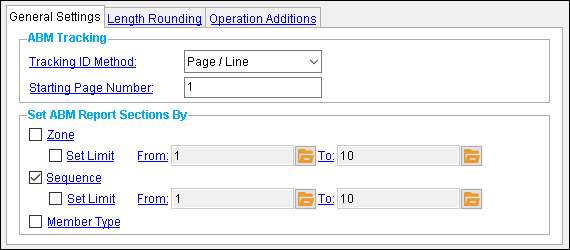
|
The ABM Report Criteria window's " General Settings " tab tells you the zones and sequences that a user in a full-featured SDS2 program has set to be included in the ABM. |

|
" Length Rounding " rules set ABM rounding per member type and main material type. The rules are applied from top to bottom, with no more than one rule applied to any one material. Rules that are more specific than ' All Member Types ' and/or ' All Material Types ' should be placed at the top. |
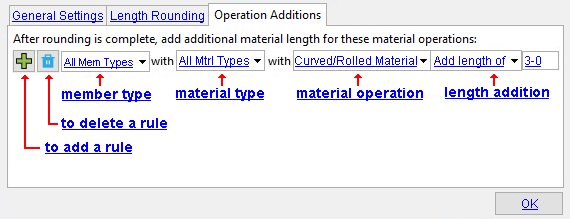
|
The " Operation Additions " tab may feature rules that add additional length to a material's rounded value to accommodate special operations such as rolling. |
To open this window :
- On the ABM Report window, select the " ABM Name " you want, then press the " View ABM Criteria " button.
page 1 | contents | abm report > create a new abm file > abm report criteria | top
| General Settings | Length Rounding | Operation Additions |
------ ABM Tracking ------
Tracking ID Method: ' Page / Line ' or ' System ABM ID '. This is the method for tracking the page-line assignment of materials in the " ABM Name ."
| Page/Line | ABM ID | Comments |
| 1-1 | 1.1.0 | In the original ABM (rev 0), the material (8 pieces) is on page 1, line 1. |
| 1-1 | 1.1.1 | The quantity of the material on page 1, line 1 changed (was reduced by 2 pieces). This change in quantity was the first revision (xxx.1) to that material in the ABM. |
| 4-1 | 1.1a.0 | A material (2 pieces) that was originally on page 1, line 1 was moved to page 4, line 1 for the ' Page / Line ' tracking method. For the ' System ABM ID ' tracking method, the material was moved to a line immediately below line 1 on page 1. |
' Page / Line ' tracks the page and line that a material is placed on.
' System ABM ID ' provides revision information and also tracks the page and line that a material is on in the ABM.
Member and material review windows: ID
ABM Report Layout: ABM ID
Starting Page Number: The starting page number ( 1 to 99999 ) used in all revisions of the " ABM Name " file.
The " Starting Page Number " affects the first number that is referenced by either " Tracking ID Method ."
In a full-featured SDS2 program, users may have set different ABMs to begin on different pages so that those ABMs do not have overlapping pages. Preventing overlapping page numbering prevents different materials in the 3D model from being assigned the same page-line .
------ Set ABM Report Sections By ------
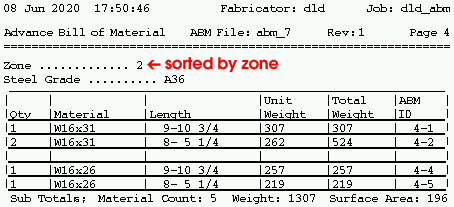
In a full-featured SDS2 program ...
If this box is checked (
), materials that are otherwise exactly the same will, when the ABM is created or updated, be assigned to different ABM pages if those materials are in different zones. Since they will appear on different pages, they will be assigned different page-lines . User-entered zone names will be reported if zone names have been entered at Home > Project Settings > Job > Zone and Sequence > press " Edit Zone Names " > Zone Names .
If the box is not checked (
), sorting by zone will not take place, but all zones in the zone range specified below will still be included. The user of that full-featured SDS2 program should leave this box not checked if already sorting by sequence .
In a full-featured SDS2 program ...
If this box is checked (
), the user of that program can set a " From " [a starting zone] " To " [an ending zone] zone range. The zone range that is entered limits the materials in the ABM that is being created or updated to only those materials that are within the range.
Example: If the user of that full-feature SDS2 program specified a zone range of 1 to 1, then only materials that are included in that zone range can be included in reports that are based on the original version of the ABM being created. Later versions of that ABM can made to include a different zone range by pressing the " View ABM Criteria " button, changing the zone range, then updating the ABM.
If the box is not checked (
), materials from any zone in the model may be included in the ABM.
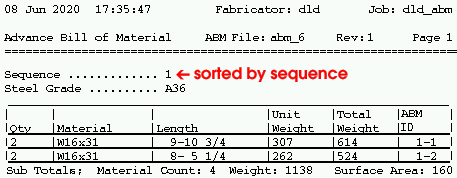
In a full-featured SDS2 program ...
If this box is checked (
), materials that are otherwise exactly alike will be assigned to different ABM pages if they are in different sequences. Since they will appear on different pages, they will be assigned different page-lines . User-entered sequence names will be reported if sequence names have been entered at Home > Project Settings > Job > Zone and Sequence > press " Sequence Names " > Sequence Names .
If the box is not checked (
), sorting by sequence will not take place, but all sequences in the sequence range specified below will still be included. The user of that full featured SDS2 program should leave this box not checked if sorting by zone.
Set [sequence range] limit: ![]() or
or ![]() .
.
In a full-featured SDS2 program ...
If this box is checked (
), the user of that program can set a " From " [a starting sequence] " To " [an ending sequence] sequence range. The sequence range that is entered limits the materials in the ABM that is being created or updated to only those materials that are within the range.
Example: If the user of a full-featured SDS2 program specified a sequence range of 2 to 2, then only materials that are included in that sequence range can be included in reports that are based on the original version of the ABM.
If the box is not checked (
), materials from any sequence in the model may be included in the ABM.
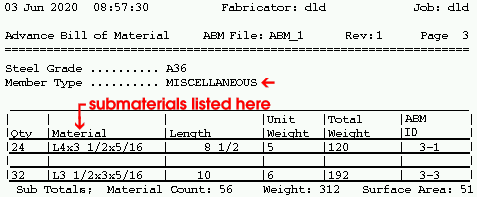
|
| On pages for member type " Miscellaneous ," submaterials are sorted under the column " Material ." |
In a full-featured SDS2 program ...
If this box is checked (
), member main materials that are otherwise exactly the same will appear on different pages of reports printed from this ABM if they are associated with different member types. Beams, columns, vertical braces and horizontal braces are examples of member types.
If the box is not checked (
), sorting by member type will not take place.
page 1 | contents | abm report > create a new abm file > abm report criteria | top
| General Settings | Length Rounding | Operation Additions |
Length rounding for materials in ABM: (non-point to point)

Length rounding rules :
Items that can be selected in a full-featured SDS2 program to be parts of a rule :
Member type: All Member Types (beams, columns, ...) or Beams or Columns or Vertical Braces or Horizontal Braces or Joists or Girts (legacy) or Purlins or Stairs or Miscellaneous (legacy).
' All Member Types ' includes only the types of members for which a member type specific rule can be defined (beams, columns, etc.). ' All Member Types ' does not include, for example, custom members, which you cannot select as a " Member Type " to define a rule.
Material type: All Material Types (flat plate (length) ...) or Flat plate (length) or Flat plate (width) or Channel or Angle or Pipe or Wide flange tee or Tube steel or Wide flange or Joist .
' All Material Types ' includes only the types of materials for which a material type specific rule can be defined (flat plate (length), etc.).
Rounding: Round up or Exact length or Round down .
Round up : The distance that length values in the ABM are rounded up to. This also affects the weight reported in the ABM since weight is calculated using the material's reported length. Rounding may also cause materials with slightly different lengths to be grouped together on the same page-line . Example: If a material's length is 11-11 1/4 (143 1/4 inches) in Modeling and ' 1 ' inch is entered here, that material will be reported in the Advanced Bill of Material Report as being 12-0 feet long (144 inches).
Exact length : The material length that is reported in the ABM is its exact length. Any rounding distance that is entered is ignored, giving you the same results as if you were to enter 0 for ' Round up ' or 0 for ' Round down '. If ' Exact length ' is selected, materials that might otherwise be grouped together on the same page-line are likely on different page-lines.
Round down : The distance that length values in the ABM are rounded down to.
Overrun: The distance that a material is permitted to increase in length before a drop and add is made when an ABM is updated. An overrun of ' 0 ' causes drops and adds to take place whenever a material's length increases. A larger overrun results in less frequent drops and adds due to length increases.
Example: In a full-featured SDS2 program, an increase to a member main material's length is made by stretching that material's member in the model after a new ABM has been created. When a user of that program updates the ABM then prints an ABM Add/Drop Report comparing the original revision to the latest revision, the report reveals that the stretched material was automatically dropped and a material of the new length was added because the change in the material's length exceeded the specified overrun that was entered here.
Underrun: The distance that a material is permitted to decrease in length before a drop and add is made when an ABM is updated in a full-featured SDS2 program. An underrun of ' 0 ' causes drops and adds to take place whenever a material's length decreases. A larger underrun results in less frequent drops and adds due to length decreases.
Example: A value of 2 inches is entered here and ' Exact length ' rounding is specified. A new ABM is created in a full-featured SDS2 program. Then the length of a material in that ABM is made 2 inches shorter in Modeling . When the user of that program updates the ABM and prints an Advaced Bill of Material Report based on the latest revision, the user finds that the item is listed on the same page-line. The user then decreases the material's length by another 2 inches and updates again and finds that a length of 4 inches less is reported and that the material is listed on a different page and line.
![]() can be used to add a new rule to the " Length Rounding " tab in a full-featured SDS2 program. The "+" button does nothing in SDS2 Site Planning.
can be used to add a new rule to the " Length Rounding " tab in a full-featured SDS2 program. The "+" button does nothing in SDS2 Site Planning.
![]() can be used in a full-featured SDS2 program to remove a rule so that it is no longer shown under the " Length Rounding " tab. The button doesn't do anything in SDS2 Site Planning.
can be used in a full-featured SDS2 program to remove a rule so that it is no longer shown under the " Length Rounding " tab. The button doesn't do anything in SDS2 Site Planning.
page 1 | contents | abm report > create a new abm file > abm report criteria | top
| General Settings | Length Rounding | Operation Additions |
After rounding is complete, add additional length for these rounding operations:

Operation additions rules :
Items that can be selected in a full-featured SDS2 program to be parts of a rule :
Member type: All Member Types or Beams or Columns or Vertical Braces or Horizontal Braces or Joists or Girts (legacy girts) or Purlins or Stairs or Miscellaneous (legacy).
Material Type: All Member Types (beams, columns, ...) or Beams or Columns or Vertical Braces or Horizontal Braces or Joists or Girts (legacy) or Purlins or Stairs or Miscellaneous (legacy).
' All Member Types ' includes only the types of members for which a member type specific rule can be defined (beams, columns, etc.). ' All Member Types ' does not include, for example, custom members, which you cannot select as a " Member Type " to define a rule.
Material Operation: Curved / Rolled Material or Mill Cut End or Bevel Cut End or Square Cut End or Standard Cut End .
' Curved / Rolled Material ' may be rolled section material or bar material. Beam main material is rolled when a " Rolling operation " has been set.
' Mill Cut End ' may be applied to columns automatically. per choice made to Home > Project Settings > Fabricator > Detailing > Member Detailing Settings > the " Columns " section > " Mill cut ends of columns ."
' Bevel Cut End ' is automatically applied, for example, to main material for sloping beam-to-beam connections or sloping beam-to-column connections, column-to-sloping beam connections, and beam-to-rotated beam connections. Exception: see " Square cut ends of sloped beams ."
' Standard Cut End ' is the default type of cut assigned to a member main material. No special annotation is placed on member details with this type of cut.
Tracking cuts: End cuts other than ' Standard cut ' are noted on member details. In Modeling , a rolled section's " End-cut type " tells you the type of cut. Annotations for square cut, mill cut & bevel cut appear on member details
Length Addition: Add Length of or Round Up to Nearest plus a distance . The entry made here also affects the weight that is reported in the ABM since ABM weight is calculated using the material's reported length. " Length Addition " does not affect the model -- it only affects the ABM.
' Add Length of ' instructs the program to take the length of the material reported in the model then add to that length the distance that is entered here, then store the resulting added-to length in the ABM.
' Round Up to Nearest ' specifies that length values in the model be rounded up in the ABM to the distance that is entered. Rounding can cause materials with slightly different lengths to be grouped together on the same page-line . Example: If a material's length is 11-11 1/4 (143 1/4 inches) in Modeling and you enter ' 1 ' inch here, that material will be 12-0 feet long (144 inches) in the ABM.
![]() can be used to add a new rule to the " Operation Additions " tab in a full-featured SDS2 program. The button does nothing in SDS2 Site Planning.
can be used to add a new rule to the " Operation Additions " tab in a full-featured SDS2 program. The button does nothing in SDS2 Site Planning.
![]() can be used to delete a rule in a full-featured SDS2 program so that the rule is no longer shown under the " Operation Additions " tab. The button does nothing in SDS2 Site Planning.
can be used to delete a rule in a full-featured SDS2 program so that the rule is no longer shown under the " Operation Additions " tab. The button does nothing in SDS2 Site Planning.
page 1 | contents | abm report > create a new abm file > abm report criteria | top
" OK " closes the ABM Report Criteria window.
page 1 | contents | abm report > create a new abm file > abm report criteria | top